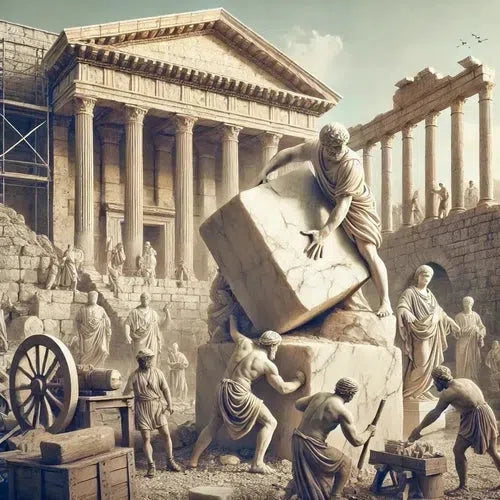Was Marble Hard to Use in the Roman Empire?

The Challenges of Working with Marble in the Roman Empire
Marble has long been associated with luxury, beauty, and power. In the Roman Empire, marble was used to create some of the most iconic structures and artworks in history. However, working with marble was no easy task, and the Romans faced numerous challenges in quarrying, transporting, and sculpting this precious stone. Despite these difficulties, the Romans developed advanced techniques and tools that allowed them to create the magnificent buildings and statues that continue to inspire awe today. This blog explores the challenges of working with marble in the Roman Empire and the ingenuity that allowed the Romans to overcome them.
Quarrying Marble: A Herculean Task
The first challenge the Romans faced in working with marble was extracting the stone from quarries. Marble is found in mountainous regions, often in remote and difficult-to-access locations. Quarrying marble required the removal of large blocks of stone from the mountainside, a task that demanded significant labor and expertise. Learn more about ancient quarrying techniques.
Roman quarry workers, known as lapidarii, used iron tools such as picks, chisels, and wedges to cut into the marble. The process involved creating a series of grooves or channels in the stone, which were then filled with wooden wedges. The wedges were soaked in water, causing them to expand and exert pressure on the stone, eventually splitting it from the mountainside. Explore the tools used in Roman quarrying.
This method, while effective, was labor-intensive and time-consuming. The workers had to carefully plan each cut to ensure that the marble block was of the desired size and quality. Any mistakes in the quarrying process could result in the loss of valuable material, making the work both physically demanding and mentally taxing. Understand the challenges of quarrying in ancient Rome.
Transporting Marble: An Engineering Challenge
Once the marble blocks were quarried, the next challenge was transporting them to their final destination. Marble is a dense and heavy material, making it difficult to move, especially over long distances. The Romans developed a variety of methods to transport marble, depending on the size of the block and the distance it needed to travel. Learn about the logistics of transporting marble.
For shorter distances, marble blocks were often transported on wooden sledges, which were pulled by teams of oxen or slaves. The sledges were sometimes greased with animal fat to reduce friction and make the movement of the stone easier. For longer distances, the Romans constructed specialized roads, known as lapidarian roads, which were designed to support the weight of the marble blocks. Explore the engineering behind Roman roads.
In cases where the marble needed to be transported by water, the blocks were loaded onto specially constructed barges. These barges were capable of carrying several tons of marble and were used to transport the stone down rivers and along the coast to major cities like Rome. Once the marble reached its destination, it was unloaded and transported to the construction site, where it would be shaped and polished. Discover the role of waterways in Roman marble transport.
Sculpting and Shaping Marble: Mastering the Craft
Sculpting marble into statues, columns, and decorative elements required a high level of skill and craftsmanship. Roman sculptors, known as sculptores, used a variety of tools to shape the marble, including chisels, rasps, and hammers. The process of sculpting marble was painstakingly slow, as the sculptors had to carefully remove material bit by bit to achieve the desired form. Learn about the tools used in Roman marble sculpting.
One of the challenges of sculpting marble was its hardness. While marble is softer than other stones like granite, it is still a difficult material to work with. Sculptors had to have a deep understanding of the stone’s properties, including its grain and veining, to avoid cracks and breakages. The sculptor would first rough out the general shape of the statue or architectural feature using larger chisels and hammers. This rough work would be followed by more precise detailing using finer tools. The final steps involved sanding and polishing the marble to achieve the smooth, reflective surface that was highly prized. Explore the techniques of Roman marble sculptors.
The skill required to sculpt marble was not limited to the physical act of carving. Sculptors also needed to have a strong sense of design and proportion, as any mistakes could not easily be corrected. Unlike working with clay or other materials, once marble is removed, it cannot be replaced. This meant that each stroke of the chisel had to be carefully considered. Understand the challenges of marble sculpture design.
The challenges of working with marble also extended to the creation of large architectural elements, such as columns and friezes. These elements had to be carved with precision to ensure that they fit together perfectly when assembled on-site. This required not only skilled artisans but also precise measurements and planning, which the Romans excelled at. Learn how Romans mastered architectural stonework.
Innovations in Marble Work
Despite the challenges, the Romans were able to achieve remarkable feats with marble, thanks in part to their innovative approaches to stonework. One such innovation was the use of the “pointing machine,” a device that allowed sculptors to accurately transfer the proportions of a model to the marble block. This tool made it easier to create life-sized statues with precise dimensions, which was especially important for large public works and portraits of emperors. Discover Roman innovations in marble sculpting.
Another Roman innovation was the development of techniques for inlaying marble with other materials, such as gold, bronze, or colored stones. This added a layer of luxury and sophistication to Roman architecture and sculpture, and it showcased the versatility of marble as a medium. The Romans were also known for their use of polychromy, where marble statues were painted to enhance their lifelike appearance, although many of these painted surfaces have been lost to time. Explore the artistic techniques of Roman marble work.
Conclusion
The use of marble in the Roman Empire was a testament to the skill, ingenuity, and determination of Roman craftsmen. While marble was a difficult material to work with, the Romans developed techniques and tools that allowed them to overcome these challenges and create some of the most enduring works of art and architecture in history. From the majestic columns of the Pantheon to the intricate statues of the emperors, marble played a central role in the visual language of the Roman Empire, symbolizing power, beauty, and permanence. Today, we continue to marvel at the achievements of Roman marble workers, whose legacy lives on in the structures and sculptures that have stood the test of time. Explore our collection of marble inspired by Roman craftsmanship.

Leave a comment